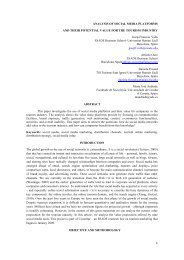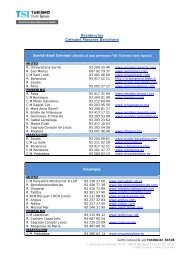customer perception of service quality in boutique hotel le six paris
customer perception of service quality in boutique hotel le six paris
customer perception of service quality in boutique hotel le six paris
You also want an ePaper? Increase the reach of your titles
YUMPU automatically turns print PDFs into web optimized ePapers that Google loves.
CUSTOMER PERCEPTION OF SERVICE QUALITY IN BOUTIQUE HOTEL LE SIX PARIS<br />
63<br />
<strong>of</strong>f between benefits and costs. The benefit component might be the same as <strong>quality</strong> and thus the<br />
perceived value is determ<strong>in</strong>ed by compar<strong>in</strong>g the perceived <strong>quality</strong> to the price paid. F<strong>in</strong>ally, the<br />
third def<strong>in</strong>ition <strong>of</strong> ‘<strong>quality</strong> as meet<strong>in</strong>g or exceed<strong>in</strong>g expectations’ is broader and more consumerfriendly,<br />
accord<strong>in</strong>g to Ek<strong>in</strong>ci (2008). Recent literature suggests that <strong>service</strong> <strong>quality</strong> is <strong>in</strong>deed the<br />
subjective assessment <strong>of</strong> <strong>service</strong> performance by consumers themselves (Dabholkar, Shepherd and<br />
Thorpe, 2000) and thus confirms the last def<strong>in</strong>ition.<br />
Different models <strong>of</strong> <strong>service</strong> <strong>quality</strong> have been <strong>in</strong>troduced by different scholars. The majority<br />
considers <strong>service</strong> <strong>quality</strong> as a multidimensional concept; however no consensus has been reached<br />
yet regard<strong>in</strong>g the underly<strong>in</strong>g generic and specific dimensions <strong>of</strong> <strong>service</strong> <strong>quality</strong> (Ek<strong>in</strong>ci, 2008). The<br />
current debate is dom<strong>in</strong>ated by two research streams: the North American versus the Nordic<br />
European school <strong>of</strong> thought.<br />
SERVQUAL, developed by scholars from the North American school <strong>of</strong> thought is the best known<br />
<strong>customer</strong>-oriented model used to measure <strong>service</strong> <strong>quality</strong> (Parasuraman, Zeithaml and Berry,<br />
1988). It measures the gap between <strong>customer</strong> expectations and their <strong>perception</strong>s <strong>of</strong> the actual<br />
experience on a five dimensional sca<strong>le</strong>: tangib<strong>le</strong>s, reliability, responsiveness, empathy, assurance.<br />
However, these dimensions have shown to be <strong>in</strong>dist<strong>in</strong>ct and other models <strong>of</strong> <strong>service</strong> <strong>quality</strong> have<br />
shown to be more parsimonious (Carmen, 1990). Moreover, new dimensions have been found whi<strong>le</strong><br />
apply<strong>in</strong>g the SERVQUAL model <strong>in</strong> diverse <strong>in</strong>dustries.<br />
In contrast, supporters <strong>of</strong> the Nordic European school <strong>of</strong> thought have developed other wellknown<br />
models <strong>of</strong> <strong>service</strong> <strong>quality</strong> based on three dimensions cal<strong>le</strong>d physical <strong>quality</strong>, <strong>in</strong>teraction<br />
<strong>quality</strong> and output <strong>quality</strong>. Service <strong>quality</strong> is determ<strong>in</strong>ed by what <strong>customer</strong>s obta<strong>in</strong> from a <strong>service</strong><br />
firm and how <strong>customer</strong>s obta<strong>in</strong> <strong>service</strong>s. Accord<strong>in</strong>g to Brady and Cron<strong>in</strong> (2001), these models<br />
were more valid when applied to different <strong>service</strong> <strong>in</strong>dustries.<br />
Follow<strong>in</strong>g the Nordic school, Ek<strong>in</strong>ci (2008) has developed a highly reliab<strong>le</strong> multi-dimensional and<br />
multi-<strong>le</strong>vel model <strong>of</strong> <strong>service</strong> <strong>quality</strong> for hospitality firms. Accord<strong>in</strong>g to the author, <strong>service</strong> <strong>quality</strong><br />
consists <strong>of</strong> primary and secondary dimensions. Two primary dimensions have been dist<strong>in</strong>guished:<br />
output <strong>quality</strong> and <strong>in</strong>teraction <strong>quality</strong>. Both dimensions are split up <strong>in</strong>to secondary dimensions.<br />
Output <strong>quality</strong> consists <strong>of</strong> physical <strong>quality</strong> and product <strong>quality</strong>, whi<strong>le</strong> <strong>in</strong>teractive <strong>quality</strong> is composed<br />
<strong>of</strong> staff behaviour and responsiveness. Depend<strong>in</strong>g on the type <strong>of</strong> hospitality <strong>service</strong> be<strong>in</strong>g researched,<br />
each secondary dimension can be split up <strong>in</strong>to specific attributes that can be measured.<br />
CUSTOMER SATISFACTION<br />
Customer satisfaction and dissatisfaction have attracted the attention <strong>of</strong> many scholars <strong>le</strong>ad<strong>in</strong>g<br />
to the development <strong>of</strong> different conceptualizations <strong>of</strong> satisfaction. Two common <strong>in</strong>terpretations<br />
can be dist<strong>in</strong>guished: transient and overall satisfaction (Ek<strong>in</strong>ci et al., 2008).<br />
First, transient or transaction-specific satisfaction evaluates each s<strong>in</strong>g<strong>le</strong> <strong>service</strong> encounter.<br />
Hotels <strong>of</strong>fer many <strong>service</strong>s to their <strong>customer</strong>s, rang<strong>in</strong>g from spa facilities to room <strong>service</strong>, thus<br />
<strong>customer</strong>s encounter many <strong>service</strong>s dur<strong>in</strong>g their stay. Consequently, the researcher should capture<br />
the <strong>customer</strong> satisfaction after each encounter.<br />
Second, overall satisfaction gathers, accord<strong>in</strong>g to a mathematical function, all transient satisfactions<br />
a <strong>customer</strong> experienced dur<strong>in</strong>g his stay. Next, performance satisfaction is def<strong>in</strong>ed as the<br />
overall satisfaction compared to one or multip<strong>le</strong> standards. Anderson and Fornell (1994) underl<strong>in</strong>ed
















